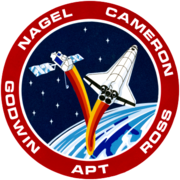 The Compton Gamma Ray Observatory after deployment, photographed from Atlantis's flight deck. | |
| Names | Space Transportation System-37 |
|---|---|
| Mission type | Compton Gamma Ray Observatory deployment |
| Operator | NASA |
| COSPAR ID | 1991-027A |
| SATCAT no. | 21224 |
| Mission duration | 5 days, 23 hours, 32 minutes, 44 seconds |
| Distance travelled | 2,487,075 mi (4,002,559 km) |
| Orbits completed | 93 |
| Spacecraft properties | |
| Spacecraft | Space Shuttle Atlantis |
| Launch mass | 116,040 kg (255,820 lb) |
| Landing mass | 86,227 kg (190,098 lb) |
| Payload mass | 17,204 kg (37,928 lb) |
| Crew | |
| Crew size | 5 |
| Members | |
| EVAs | 2 |
| EVA duration |
|
| Start of mission | |
| Launch date | April 5, 1991, 14:22:45 UTC (9:22:45 am EST) |
| Launch site | Kennedy, LC-39B |
| Contractor | Rockwell International |
| End of mission | |
| Landing date | April 11, 1991, 13:55:29 UTC (5:55:29 am PST) |
| Landing site | Edwards, Runway 33 |
| Orbital parameters | |
| Reference system | Geocentric orbit |
| Regime | Low Earth orbit |
| Perigee altitude | 450 km (280 mi) |
| Apogee altitude | 462 km (287 mi) |
| Inclination | 28.45° |
| Period | 93.70 minutes |
| Instruments | |
| |
 STS-37 mission patch  Standing in EVA suits: Apt and Ross Seated: Cameron, Nagel and Godwin | |
STS-37, the thirty-ninth NASA Space Shuttle mission and the eighth flight of the Space Shuttle Atlantis, was a six-day mission with the primary objective of launching the Compton Gamma Ray Observatory (CGRO), the second of the Great Observatories program which included the visible-spectrum Hubble Space Telescope (HST), the Chandra X-ray Observatory (CXO) and the infrared Spitzer Space Telescope.[1] The mission also featured two spacewalks, the first since 1985.
- ^ "SPACE SHUTTLE MISSION STS-37 PRESS KIT" (PDF). NASA. April 1991. Retrieved July 1, 2011.
 This article incorporates text from this source, which is in the public domain.
This article incorporates text from this source, which is in the public domain.